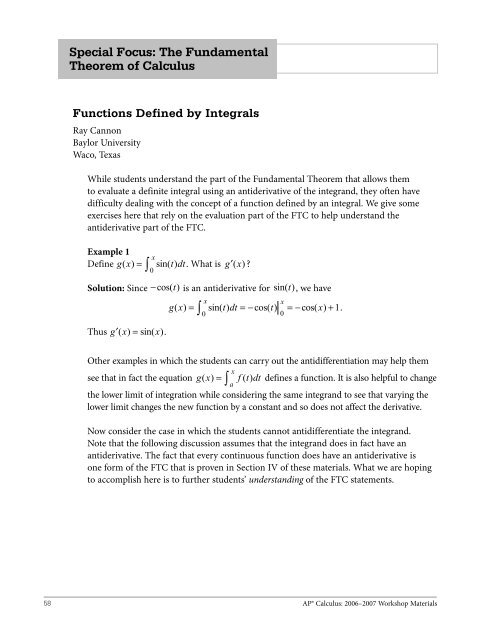AP Calculus
Create successful ePaper yourself
Turn your PDF publications into a flip-book with our unique Google optimized e-Paper software.
Special Focus: The Fundamental<br />
Theorem of <strong>Calculus</strong><br />
Functions Defined by Integrals<br />
Ray Cannon<br />
Baylor University<br />
Waco, Texas<br />
While students understand the part of the Fundamental Theorem that allows them<br />
to evaluate a definite integral using an antiderivative of the integrand, they often have<br />
difficulty dealing with the concept of a function defined by an integral. We give some<br />
exercises here that rely on the evaluation part of the FTC to help understand the<br />
antiderivative part of the FTC.<br />
Example 1<br />
x<br />
Define g( x) = ∫ sin( t)<br />
dt. What is g′<br />
( x) ?<br />
0<br />
Solution: Since −cos( t ) is an antiderivative for sin( t ), we have<br />
Thus g′ ( x) = sin( x).<br />
x<br />
x<br />
∫ 0<br />
0<br />
g( x) = sin( t) dt = − cos( t) = − cos( x)<br />
+ 1.<br />
Other examples in which the students can carry out the antidifferentiation may help them<br />
x<br />
see that in fact the equation g( x) = ∫ f ( t)<br />
dt defines a function. It is also helpful to change<br />
a<br />
the lower limit of integration while considering the same integrand to see that varying the<br />
lower limit changes the new function by a constant and so does not affect the derivative.<br />
Now consider the case in which the students cannot antidifferentiate the integrand.<br />
Note that the following discussion assumes that the integrand does in fact have an<br />
antiderivative. The fact that every continuous function does have an antiderivative is<br />
one form of the FTC that is proven in Section IV of these materials. What we are hoping<br />
to accomplish here is to further students’ understanding of the FTC statements.<br />
58<br />
<strong>AP</strong>® <strong>Calculus</strong>: 2006–2007 Workshop Materials


